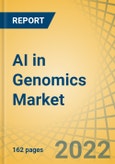Succeeding extensive secondary and primary research and in-depth analysis of the market scenario, the report studies the key industry drivers, restraints, challenges, and opportunities. The growth of the AI in genomics market is attributed to the rising focus on reducing turnaround time in drug discovery & development, increasing use of AI in healthcare/genomics, and growing investments in AI. In addition, emerging start-ups and the rising adoption of machine learning (ML) in personalized/precision medicine are likely to offer opportunities for market growth.
Based on offering, in 2022, the software segment is estimated to account for the largest share of the market. The key factors attributed to this segment's large market share are the growing adoption of AI in healthcare/genomics and the advancements in AI algorithms to analyze huge amounts of genetic datasets. For instance, in April 2022, MedGenome (U.S.) launched an AI-enabled variant interpretation software suit, VarMiner, to help clinicians, genome analysts, and molecular geneticists interpret and report variants. In the other instance, in October 2020, Fabric Genomics (U.S.) launched Fabric GEM to accelerate genetic disease diagnosis and provide comprehensive clinical-decision support.
The AI in genomics market is segmented by offering (software, services), delivery mode (on-premises, cloud & web-based), functionality (genome sequencing, gene editing, other functionalities), application (drug discovery and development, precision medicine, diagnostics, and other applications), end user (pharmaceutical & biopharmaceutical companies, academic & research institutes, and other end users), and geography. The study also evaluates industry competitors and analyzes their market shares at global and regional levels.
Based on functionality, in 2022, the genome sequencing segment is estimated to account for the largest share of the market. The factors attributing to the large market share of this segment are the increasing adoption of AI in genome sequencing studies and the growing R&D related to COVID-19.
Based on application, the market is segmented into drug discovery and development, precision medicine, diagnostics, and other applications. In 2022, the drug discovery and development segment is estimated to account for the largest share of the market. The key factors attributing to the large market share of this segment are the growing adoption of AI algorithms in drug discovery and the growing collaboration between pharmaceutical/biopharmaceutical companies and companies that provide AI solutions.
Based on end user, the pharmaceutical & biopharmaceutical companies segment is estimated to account for the largest share of the market. These companies use AI algorithms to speed up drug discovery. Furthermore, the increasing burden of chronic and infectious diseases is burdening pharmaceutical companies to speed up drug discovery. Thus, the highest adoption of AI in genomics solutions by pharmaceutical and biopharmaceutical companies contributes to this segment's large market share.
An in-depth analysis of the geographical scenario of the AI in genomics provides detailed qualitative and quantitative insights into five major geographies (North America, Europe, Asia-Pacific, Latin America, and the Middle East & Africa) along with the coverage of major countries in each region. In 2022, North America is estimated to account for the largest share of the AI in genomics market, followed by Europe, Asia-Pacific, Latin America, and the Middle East & Africa. The increasing research initiatives in genomics, the availability of infrastructure for genomics research and AI, and the growing adoption of AI in precision medicine to meet the increasing market demand are the factors contributing to the large market share of this region.
Some of the key players operating in the global AI in genomics are Microsoft Corporation (U.S.), NVIDIA Corporation (U.S.), Deep Genomics Incorporated (Canada), Fabric Genomics, Inc. (U.S.), Data4Cure, Inc. (U.S.), Predictive Oncology Inc. (U.S.), Emedgene Technologies LTD (U.S.), Congenica Ltd. (U.K.), Tempus Labs, Inc. (U.S.), SOPHiA GENETICS SA (Switzerland), Illumina Inc. (U.S.), and BenevolentAI Limited. (U.K.).
Scope of the Report:
Global AI in Genomics Market, by Offering
- Software
- Services
Global AI in Genomics Market, by Delivery Mode
- On-premises
- Cloud & Web-Based Mode
Global AI in Genomics Market, by Functionality
- Genome Sequencing
- Gene Editing
- Other Functionalities
Global AI in Genomics Market, by Application
- Drug Discovery & Development
- Precision Medicine
- Diagnostics
- Other Applications
Global AI in Genomics Market, by End User
- Pharmaceutical & Biopharmaceutical Companies
- Academic & Research Institutes
- Other End Users
Global AI in Genomics Market, by Geography
- North America
- U.S.
- Canada
- Europe
- Germany
- U.K.
- France
- Italy
- Spain
- Rest of Europe (RoE)
- Asia-Pacific (APAC)
- China
- Japan
- India
- Rest of APAC (RoAPAC)
- Latin America
- Brazil
- Mexico
- Rest of Latin America (RoLA)
- Middle East & Africa
Table of Contents
Companies Mentioned
- Microsoft Corporation (U.S.)
- NVIDIA Corporation (U.S.)
- Deep Genomics Incorporated (Canada)
- Fabric Genomics Inc. (U.S.)
- Data4Cure Inc. (U.S.)
- Predictive Oncology Inc. (U.S.)
- Emedgene Technologies LTD (U.S.)
- Congenica Ltd. (U.K.)
- Tempus Labs Inc. (U.S.)
- SOPHiA GENETICS SA (Switzerland)
- Illumina Inc. (U.S.)
- BenevolentAI Limited. (U.K.).








